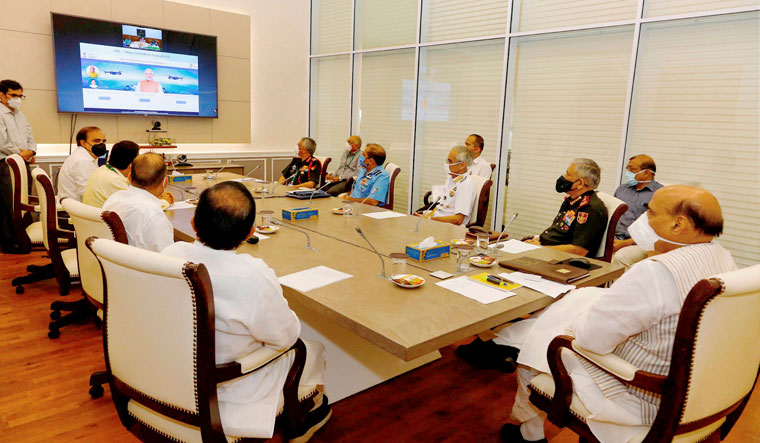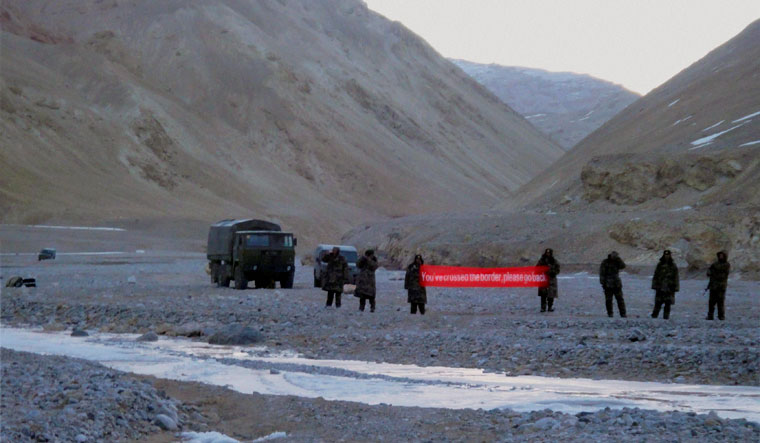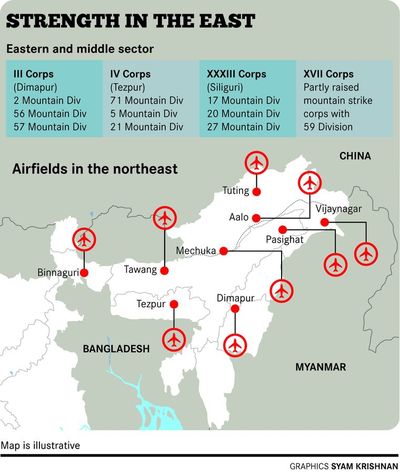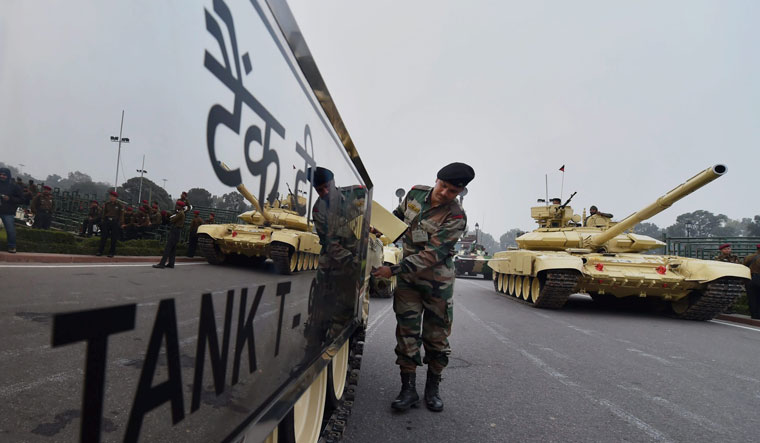After returning to Delhi from his two-day visit to the forward areas of eastern Ladakh on June 25, Army chief General M.M. Naravane first briefed Defence Minister Rajnath Singh. The duo then went to Prime Minister Narendra Modi with a detailed situation report. After interacting with soldiers injured in the Galwan clash and with his local commanders, General Naravane concluded that the situation in the Ladakh sector was way too serious. Despite promises of troop reduction, the People’s Liberation Army (PLA) of China has further strengthened its deployment on the flash points by setting upÅ permanent bunkers, pillboxes and observation posts. The prevailing sentiment on the ground on the Indian side is to impose a bigger cost on the enemy for the Galwan “betrayal”.ÅÅ
Eyeball-to-eyeball situation prevails in multiple locations where troops are separated by barely 100m, although at the June 22 meeting between corps commanders, there was an understanding to maintain a distance of at least 2.5km to 3km. What is most worrying for India is the deployment of Chinese armoured vehicles and artillery units in areas facing the Gogra Post-Hot Springs region. In response, India has moved forward its newly-inducted M777 howitzers, T-90 Bhishma tanks and other armoured vehicles. While China has deployed the S-400 air defence system, India has in place its Akash air defence system.
Even as New Delhi is exploring diplomatic and economic options to put pressure on Beijing to return to the pre-April status quo, the Army has been devising ways to show its prowess to the enemy. “Either you exercise military options or you wait and watch through negotiations. But in the wait-and-watch scenario, another Galwan type clash cannot be ruled out,” said a former deputy Army chief. “Military options, however, always have the risk of escalation.”
The PLA has 2.3 lakh troops under its western theatre command and the Tibet and Xinjiang military districts. It has recently deployed its 4th Motorised Infantry Division opposite Daulat Beg Oldie-Debang, while the 6th Mechanised Infantry Division is positioned between Pangong Tso and Chumar. There is another Chinese division opposite Demchok. A military observer said the PLA’s objective could be to threaten a section of the Darbuk-Shyok-DBO road and cut off the DBO sector, restricting India’s access to the Karakoram Pass.
Military analysts believe that India has an edge over China as it has fought and won several wars with Pakistan. Moreover, it has many fighter aircraft capable of flying at high altitudes. Chinese pilots have to fly with limited supplies and fuel because of difficult weather at their air bases in Tibet.
HOLDING THE LINE
With heavy deployment, the enemy can be restricted to wherever they are, which is known as holding the line in military strategy. To ramp up its deployment along the 826km-long front on the Line of Actual Control in Ladakh, the Army, apart from its regular deployment, has moved at least two of its divisions from their peacetime locations in Himachal Pradesh and Uttar Pradesh towards the Ladakh sector, along with two engineer regiments.
Animal Transport Units, which have not been used for several years, have been reactivated to move arms and ammunition to places without proper roads. The units, consisting of sturdy mules, have been assigned to support remote outposts located at heights of up to 19,000 feet.
The Army has moved an infantry division to look after the Galwan and DBO sector, and there is another division to take on aggression in Hot Springs, Chushul, Pangong Tso and Spanggur Gap. Another division is based at Chumur and Demchok. The frontline troops are reinforced by infantry and armoured brigades, three tank regiments and a mechanised regiment.Å
A few months ago, there was an integrated exercise of all arms by the Army in a “super high altitude area” in eastern Ladakh involving tanks, infantry soldiers, paratroopers and mechanised infantry as part of a readiness exercise to test its capabilities against China. “Holding the line is a defensive, but deterrent strategy,” said former northern Army commander Lieutenant General (retd) D.S. Hooda. “The huge deployment of troops, artillery and armoured vehicles may somehow create fear in the enemy’s mind, preventing it from moving further.”Å
QUID PRO QUO
Quid pro quo option in military parlance means tit for tat. To counter China’s ‘adamant’ behaviour on the border, India can strike at places where it enjoys tactical advantage. “We can occupy some of their areas where we can dominate them with sheer numbers. By occupying Chinese territory, our bargaining power becomes stronger and gives us negotiating leverage,” said a general. But it is an act of military escalation and may have its consequences.
Top defence ministry sources said the Army was working on places on the LAC where it had the upper hand. Military strategists believe that even in some areas in the Ladakh sector, like the plains of Depsang, India has the tactical edge. The Army enjoys numerical advantage in Depsang, Trig Heights, Dumchele, Chumar, Spanggur Gap and the south of Pangong Tso. Apart from the Tawang sector, which is heavily guarded by both sides, there are several places in the rest of Arunachal Pradesh, including Lohit, Subansiri and the Dibang valley, where the Indian Army can surprise the Chinese. Barahoti, Kaurik and Shipki La in the middle sector and the Chumbi valley near Sikkim can also be considered.
“The Chinese are not moving back, and military and diplomatic talks have not yielded much,” said Lieutenant General (retd) Mohinder Puri, former deputy chief of the Army. “I would feel comfortable if we think of a quid pro quo on the other side. Plenty of areas are available where we can surprise them.” Some military analysts, however, feel that exercising the quid pro quo option isÅ a little difficult now because the Chinese are also on alert in every sector.
Lieutenant General (retd) Vinod Bhatia, who was director general of military operations, said for a viable quid pro quo option, India needed a mountain strike corps, which had the capability for such operations. A mountain strike corps named XVII Corps was sanctioned in July 2013 after the Chinese incursion in Depsang. But the corps, headquartered in Panagarh in West Bengal, could raise only a single division in seven years. The project is now on the backburner as the Army is focusing on small Integrated Battle Groups (IBGs).ÅÅ
One plan under the quid pro quo strategy is to recapture Aksai Chin, which India lost in 1962. But the risk of a full-fledged war is probably stopping military planners from going ahead. Moreover, Aksai Chin, which links China’s Xinjiang district with Tibet, is not as strategically important for India as it is for China. “For China, Aksai Chin is very critical and the Chinese will certainly make every effort to retain it,” said an official.Å
LIMITED CONFLICT
It means forcibly evicting PLA troops from India’s territory and securing the heights through a calibrated conflict. Military strategists believe that the Indian infantry and special forces could launch coordinated surprise infantry or special-forces attacks on each one of the occupied positions, with artillery and armour support in the rear as a deterrent against escalation. This is the most vocal argument among military planners. In fact, during his visit to the forward locations in the eastern Ladakh sector, General Naravane got a sense from his men that China needed to be unequivocally told that the Indian Army was no pushover and that the PLA could not keep on unilaterally changing the status quo along the border. India can look at limited conflict options, which will be limited in time and geography.Å
The newly set up IBG is the most workable option available, as it has elements of airpower, armour, artillery, mechanised and traditional infantry engineering and ordnance units that can be activated without delay. An Army official said the IBGs could perform both offensive roles involving cross-border operations and the defensive role of withstanding an attack.
A general who supports limited conflict said the option was either to accept the ground situation or to keep fighting to get back lost territory. “When all your diplomatic channels fail, you are left with military options. Limited conflict option seems the obvious one. If you are determined to kick them out, you go for limited conflict options. Infantry and special forces can be supported with armoured elements and the newly-inducted Apache attack helicopters,” said the general. The limited conflict option, however, has the maximum chance of escalation and can result in a full-fledged war.ÅÅ
“Military options are very much there. But the key issue is whether it should be exercised at this point of time. Military options like quid pro quo or limited conflict can be considered at an appropriate time,” said Hooda. When asked about the use of airpower, he said it was an option if India decided to escalate. “I do not think we should start with airpower. It is not a Balakot-type situation, and China is not Pakistan.”
COVERT OPERATION
A section of the military believes that hitting Chinese investments in Pakistan-Occupied Kashmir through covert operations can also be a viable option. Targeting the 3,000km-long China-Pakistan Economic Corridor that connects the two countries with railway lines, roads, pipelines and optical fibre networks can be a message to Beijing. The CPEC, which is a key element of China’s Belt and Road Initiative, passes through PoK.
“China has invested heavily in infrastructure projects worth $11 billion to $12 billion in PoK even before the BRI was launched. We can activate our assets in Gilgit-Baltistan to carry out a covert operation,” said an official. Balochi nationalists can also be tapped to target Chinese interests. Observers, however, point out that China and Pakistan have taken every possible precaution to ensure CPEC’s security. China has recently supplied armed drones to Pakistan specifically for the purpose.Å
Another option before India is to target restive regions in China like Xinjiang and Tibet. “If China can raise the issue of Kashmir, we can also start talking about Tibet and Xinjiang,” said a military strategist.
MARITIME OPTION
Another option before India is to put pressure on China with naval operations in the Strait of Malacca and other chokepoints in the Indian Ocean Region, which are critical for Chinese energy supply. India can also target the new Chinese oil terminal in Made Island in the Bay of Bengal off the Myanmarese coast, which receives tankers from Africa and the Middle East and transports oil through pipelines to Kunming in China. “We can use our naval assets to block Chinese vessels in these chokepoints,” said an observer. “China is dependent on the sea lanes of communications in the Indian Ocean Region for its energy imports. Targeting its interests will be a viable option.”
Besides working on immediate options, military planners believe that India should be ready for the ‘long haul’. Former Army chief General (retd) Deepak Kapoor said the 2017 Doklam standoff took 73 days to resolve, and the ongoing crisis could last much longer. “I will look at it as a long-term problem which is not going to be sorted out overnight. It will take months. I do not foresee a solution anytime soon,” he said.Å He added that even if military action was required, it had to be supported with diplomacy. “If nothing gets resolved through talks or negotiations, then the possibility of military option remains. We have multiple options and the capability to strike at the right time. Though we recognise that China has a much larger defence expenditure than us, we also have the capability to surprise China,” he said.
As winter approaches, it will not be possible for China to keep occupying the heights, as temperatures will drop to minus 40 degrees Celsius. “First of all, the PLA is not used to such high altitudes,” said Bhatia. “The cost of occupying the heights is manifold and if China is ready to pay it, let us see.”









